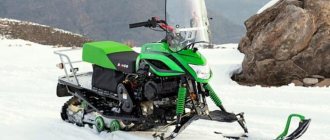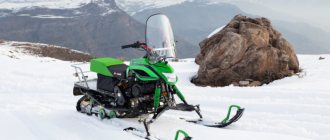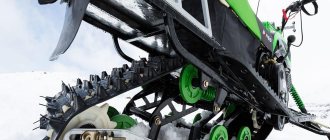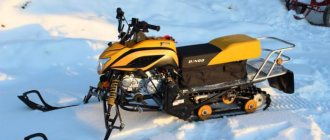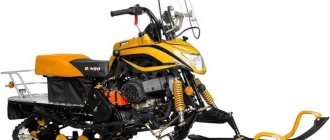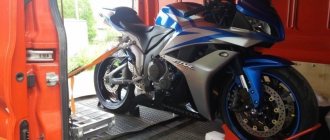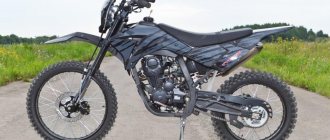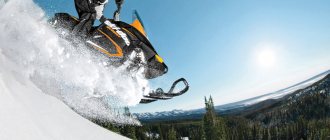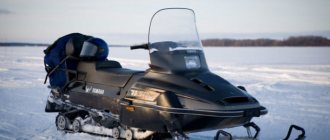Irbis Dingo T125 is a Russian-Chinese development, one of the most affordable and technologically advanced snowmobiles in the post-Soviet space. The machine has a simple and unpretentious design, which is easy to maintain without the help of specialists. This is an important factor for long-term and uninterrupted operation, which is very important for Russian users. The model under consideration is built from proven technical solutions, which are supplemented with more modern components so that the model remains relevant for several more years. The Irbis Dingo T125 snowmobile has extensive off-road capabilities. It has optimal ride quality. The machine undergoes rapid disassembly and assembly, and in this case it can be compared with a conventional construction set. In addition, we have before us a promising competitor not only to the best Russian, but also to foreign snowmobiles.
Dingo T125 is the second generation of the snowmobile of the same name, developed with the participation of Chinese and Russian engineers. Based on this, it is not surprising why the model is ideally suited to harsh climatic conditions - for example, to the northern regions of Russia. The machine is based on a modular design, which makes it possible to disassemble or assemble the machine within 15 minutes. Moreover, for this you will need a basic set of tools, including wrenches and bicycle bolts for reliable connection of components. We also note the very compact dimensions of the Dingo T125, which allows you to transport the car in the trunk of a car. Of course, the developers did not ignore the newfangled technologies introduced in this snowmobile. For example, among the simplest and most useful options, we note the presence of a 12-volt outlet, to which you can connect a variety of accessories - smartphones, GPS navigators, etc.
Basic equipment
- Electronic instrument panel
- 12V socket
- Electric starter
- Heated handle
- High windshield
- Spacious luggage compartment under the seat
- Emergency engine shutdown system.
Instructions: checking, changing engine oil and adjusting track
For high-quality and uninterrupted operation of the Irbis Dingo snowmobile, it should be periodically serviced.
Checking the engine oil and replacing it
At the Irbis Dingo plant, the snowmobile is filled with oil specifically suitable for 10W39SF gasoline units. Before you start using your snowmobile, you will need to measure the oil.
Clutch oil should be used, but standard 4-stroke oil is also suitable. Oil viscosity is selected taking into account the climate in accordance with a specific scheme
Daniila Rukin
Snowmobile specialist "Buran". I go fishing in my free time.
Ask a Question
Do not pour used oil into waste containers, or pour it onto the ground or wastewater.
Checking the oil level: You need to check the level of this fluid before any trip. For this it is recommended:
- park the snowmobile so that it stands level, not in an inclined position;
- warm up the power unit;
- to ensure the comfort of monitoring the oil level, there is an inspection window on the right side of the engine in the direction of travel;
- the oil level should be located between the maximum “H” and minimum “L” marks as in the figure above;
- If necessary, you can add oil to the crankcase.
It is important not to overfill higher than the top mark. Using a motor with insufficient oil will cause damage.
Changing engine oil: to ensure quick and complete drainage of old oil, you must:
- Place the snowmobile on a flat surface and warm up the engine;
- to drain the oil, you will need to unscrew the dipstick (1) and the passage plug (2), as in the figure;
- Next, you should wait until the oil drains completely and tighten the passage plug from the crankcase;
- pour 1 liter of oil of a suitable type into the engine crankcase, then turn it on and let it idle for about three minutes;
- two minutes after the power unit stops operating, you need to see that the oil level is fixed at the top of the control window.
If desired, you can add oil to the upper limit of the dipstick. It is important to make sure that the oil does not leak.
How to adjust track tension?
To configure you will need:
- Make preparations. You will need to heat up the suspension and the track belt itself after driving more than two kilometers. Raise and fix the snowmobile so that the tracks rotate without connecting to the snow or other surface, then move the lever to the normal position. Clean the chassis from dirt and ice, inspect the springs, check the quality of the skid plates, check the rollers.
- Check and adjust tension. Make the bolts that are used for tension a little looser, check the degree of sag from the track track to the bottom of the slide in the center of the slide. The length between these elements should be about 30 mm (as in the figure above). If it is clear that adjustment of the nuts is required, then you need to: tighten the nuts and loosen the tension, or unscrew the nuts and tighten the tension.
- Perform centering. Start the engine, slowly adding speed to ensure smooth rotation of the gooseneck. In this case, you need to look at its tension and location, check that the sprocket threads fit into the windows. The teeth of the sprockets should be in the center of the hole - the hooks in the gooseneck.
The main signs of an over-tensioned track: the vehicle is difficult to move from a standstill, it is also difficult to accelerate, it overheats under normal conditions, and the slides wear out greatly.
The main signs of a weakly tensioned track: the drive axle stars slip relative to the track, displacement occurs, as well as their rubbing and removal of the cart during lateral impact.
Track Centering
How to do it:
- It is necessary to turn on the engine, slowly adding speed to achieve rotation of the track.
- Observe the tension and location of the track in relation to how the rear sprocket teeth fit into the perforation windows.
- It is important that the teeth of the sprockets at the rear are in the center of the rectangular holes - the track hooks.
- The length between the outer boundaries of the passages and the ends of the rollers should be similar and remain the same after turning the gooseneck in its raised state.
- If the goose falls on one part, then it will need to be tightened on the side where it went down, or you can slightly loosen it on the other side, taking into account the achieved state of tension.
- The smallest (possible) gap between the sidewalls of the sprocket and the perforation windows is 0.5 mm.
Once you have tensioned and centered the track, you can tighten the bolts to secure the track.
Daniila Rukin
Snowmobile specialist "Buran". I go fishing in my free time.
Ask a Question
When the track is too tight, the snowmobile has difficulty moving, accelerating, and the engine overheats under simple conditions of use. Damage to the mucus is observed.
When the caterpillar is weakly tensioned, the stars from the drive axle slip relative to the caterpillar, the caterpillar is displaced relative to the slips themselves, the tracks are wiped by the slips, and they are removed from the cart under a lateral load.
Top 3 modifications of Dingo
The Dingo snowmobile is available in different versions:
- T125
- T150
- T250
Before purchasing a specific model, it is recommended that you familiarize yourself with the features of each option.
Dingo T125
The predecessor of this model is a snowmobile, the movement of which is driven by an air-type propeller.
Peculiarities:
- The Choho Dingo T125 530 drive chain includes 50 links.
- The T125 snowmobile was produced in close cooperation with specialists from Russia and China. This device takes into account all the features of the Russian Federation.
- The snowmobile is equipped with a Lonkin gasoline power unit.
- This is a copy of a motor created by specialists from Japan.
- Simple and high quality engine. It is used this way on pit bikes and low-power ATVs.
If necessary, spare parts can be easily purchased; they are available in the online store.
Dingo T150
This snowmobile is a successor to the T125 - the previous snowmobile model, which is equipped with a 4-stroke engine with one cylinder running on gasoline.
- Power 9.5 horsepower.
- The engine capacity is almost 150 cm3. The carburetor system includes heating of the damper - this function ensures that the engine starts in a few seconds.
- For Dingo T150, a drive chain with a length of about 430 and a number of links of about 44 is used.
- Dingo T150 is the third generation of snowmobiles from Russia.
- The modular design allows for quick disassembly for transportation in a passenger car.
- The gearbox and reverse provide active control when reversing. The rear suspension has 2 shock absorbers that effectively absorb any shock and vibration while driving.
- Snow hooks on a long track provide the ability to drive the vehicle in different conditions.
On this model, the steering wheel grips have a heating function, there is a compartment for various small items, which is located under the seat and luggage compartment in the rear.
Dingo T250
Peculiarities:
- This model is equipped with a high-power power unit.
- The cooling principle is forced oil.
- The 15 horsepower engine is turned on manually or using an electric starter.
- The maximum speed that a snowmobile can reach is 60 km/h.
- The track, consisting of rubber fabric and skis, is what gives good maneuverability. The model is equipped with a variator with reverse.
- The brake mechanism is hydraulic.
- The suspensions are independent, they effectively cope with unevenness while driving.
- The fuel system, which includes the carburetor diffuser heating function, is powered by 92-grade gasoline.
- Refill capacity 7 liters.
The T250 model features improved construction quality as well as an optimized disassembly function. It only takes a few minutes to assemble or disassemble.
Video
Since the Dingo 125 snowmobile is fully designed for independent operation and maintenance, then you should consider its disassembly process, which consists of several stages that do not require professional training:
- It is necessary to turn off all electronic systems, as well as the rear light (it is located under the seat)
- Remove the screws to detach the chair frame from the plastic panels. After dismantling the mounting wing on the plastic, you can easily reach and remove this component, which is one of the elements of the power unit block.
- We pull out the seat frame after all the bolts have been unscrewed. After this, the chain casing is dismantled. For this procedure you will need to loosen the tensioner.
- The motor block and track base are fixed on both sides with screws. We unscrew them and then remove the luggage compartment. Please note that the tracked unit should be pulled out carefully, with smooth (not sudden) movements. For convenience, we follow the guides.
- As a result, the disassembled snowmobile is divided into two parts, one of which contains the steering wheel. We unscrew it and proceed to dismantling the front suspension, which is also bolted. The steering shaft must be pulled towards you to completely remove the front suspension.
- After removing the suspension, remove the skis. The procedure is carried out in a similar way.
- Assembling the device is carried out in reverse order.
Among other important features of independent operation, we note the rules for breaking in the Dingo 125 snowmobile. Proper running in will allow you to use the machine without serious problems with reliability. In addition, running-in significantly extends the life of parts. Practice shows that the machine should be operated in a gentle mode for at least 500 kilometers, after which the snowmobile is considered fully adapted to local conditions. During the running-in process, parts are ground in, making them more durable and resistant to damage.
So, during the first 500 kilometers, the Dingo 125 snowmobile must be driven with extreme caution. For example, the speed should not exceed 30 km/h, and the continuous driving time should not exceed 60 minutes. High loads on the motor are unacceptable. This means that it is better to avoid transporting trailers and traveling together for a while. It is not recommended to allow the crankshaft to spin up to 7000 rpm, otherwise the internal combustion engine may overheat, and all running-in will be in vain. After passing the first “hundred” kilometers, you should change the oil and carry out scheduled maintenance.
The Dingo 125 snowmobile is characterized by regular and timely maintenance. It doesn't take long. In general, in this case, attention is paid mainly to the three most important components - the condition of consumables, tracks and the carburetor system. Of course, if necessary, it is worth paying attention to other characteristics. And yet, the components described above are the most sensitive in the Dingo 125 snowmobile.
So, if you need to fill in new oil, let’s pay attention to its parameters - the marking should look like 10W30SF. The tracks are adjusted using tensioners. In this case, we inspect and adjust the locking nuts. Before adjusting the idle speed, the engine must first be warmed up for 10 minutes, then we try to reduce and increase the crankshaft speed using a special adjustment screw.
To follow modern trends, the Dingo 125 snowmobile received a multifunctional dashboard consisting of the following elements:
- Button for changing modes, allowing you to display certain information
- A button responsible for setting dashboard modes. We are talking about the ability to change the image format
- Clock display
- Speedometer to display the current speed of the snowmobile
- temperature sensor
- Device for displaying crankshaft revolutions (tachometer)
- Indicators indicating the engagement of a specific gearbox gear
- Engine heating indicator. In a critical situation, the lamp lights up if the engine has a temperature of more than 300 degrees
- Daily mileage indicator.
Specifications
It is suggested that you familiarize yourself with the technical characteristics of the Dingo T125 snowmobile:
Dimensions (windshield length)
2510/980/1010
Propulsion type
Crawler (front sprocket arrangement)
Engine type and characteristics
Gasoline four-stroke (oil cooling). The block includes 1 cylinder with a volume of 125 cc. ml. The usual crankshaft speed is 7.5 rpm. When the above mark is reached, the rated power reaches 5.2 kilowatts/7.07 liters. With. One carburetor power system.
Suspension (front and rear)
The front is independent, the rear is roller-slide.
Transmission
Type - semi-automatic gearbox, number of gears - 4, clutch - automatic in oil bath
Fuel system
The capacity of the fuel tank is 5 liters. consumption per 100 km = 1.5 l. Gasoline AI-92.
Speed (max)
50 km/h
Electronic equipment: light and additional functions
The front headlight is halogen. The following additional functions are provided: heated steering wheel and throttle trigger.
Brakes (type and mechanism)
Hydraulics, mechanism – mechanical disk
Spare parts
Dingo snowmobiles operate in conditions that are not comfortable, are used at low temperatures, and are in contact with a humid environment. The design of snowmobiles is suitable for such conditions and has a long service life. But over time, repairs are required. In the catalog you can purchase the following spare parts for the Dingo snowmobile:
- power units, carburetor, instrument panel
- luggage compartment
- spare parts
- brake discs
- headlights
- stars
- mufflers
- shock absorbers, etc.
It is recommended to purchase spare parts for Dingo snowmobiles through an authorized dealer. In order for the machine to operate properly and not require inspection over a long period of operation, the spare parts chosen must be reliable from trusted manufacturers.
Tuning Dingo 125
Every owner of an IRBIS Dingo T125 or T150 snowmobile has probably encountered a problem when the snowmobile gets stuck in deep snow. And often it’s not about engine power at all. It's all about grip on the surface; the wider the skis, the better the glide, and the possibility of falling into the snow is greatly reduced. In addition, when driving on loose snow, the snowmobile encounters great resistance and snow gets into the chassis and engine compartment, which in turn slows down the ride.
In order for the T125 tracks not to bury themselves in the snow, it is not necessary to buy new skis and radically change the design, but just install ski extensions and protection for the bottom and levers, also known as the “third ski.”
Thus, having made a small tuning, and most importantly simple and inexpensive, you will immediately feel the difference when overcoming snow obstacles. To modernize the Dingo snowmobile, I advise you to purchase a cross-country ability kit. These are protection for the bottom, levers and extensions (linings) of skis of domestic production. All products are of high quality and have a long service life.
Cost of Irbis Dingo T150
At the moment, you can buy this model at a price within the following range: from 75 to 98 thousand rubles. It is inexpensive, its price varies depending on when it was produced.
The cost varies depending on the year of manufacture and type of equipment. A used snowmobile costs between 48-70 thousand rubles. The main factors that influence the price of an option are the year of production, mileage and condition.
Owner reviews
Dingo T150 has many reviews and some of them are presented below:
- I recently purchased a new snowmobile and I was simply delighted with the ergonomics, which were performed at the highest level. I don’t know whether the manufacturer did this on purpose or whether this happened due to the design features of the machine, but operating this model is quite simple and convenient. The seating position is upright, there are quite comfortable footrests, heated grips and a comfortable seat. There is a feeling of comfort in all this. The control levers came out very organic, which is also a plus. The only negative, in my opinion, is the windshield, which is practically useless. The main task of this glass is to cut off cold oncoming flow, but this does not happen. Because the glass is installed at a right angle and the entire flow is directed directly into the face. I didn't notice any other shortcomings.
- I've already covered 1,500 kilometers and I can quite confidently say that it fully met my expectations and even exceeded them in some moments. I often carry loads weighing up to 120 kilograms and practically no changes in dynamics are felt, since the snowmobile confidently pulls the sled and picks up speed. I haven’t accelerated more than 40 kilometers per hour yet, because it’s just scary. Due to the narrow base, there is a risk of falling off the snowmobile. I was also pleased with the heated steering grips, which provide additional driving comfort and economical fuel consumption, although I haven’t measured it in numbers myself, it doesn’t really hurt my pocket. Among the disadvantages, I would like to note that it is harder for a snowmobile to pull with a passenger, and it is also inconvenient for itself. Otherwise, I'm completely satisfied with it.
